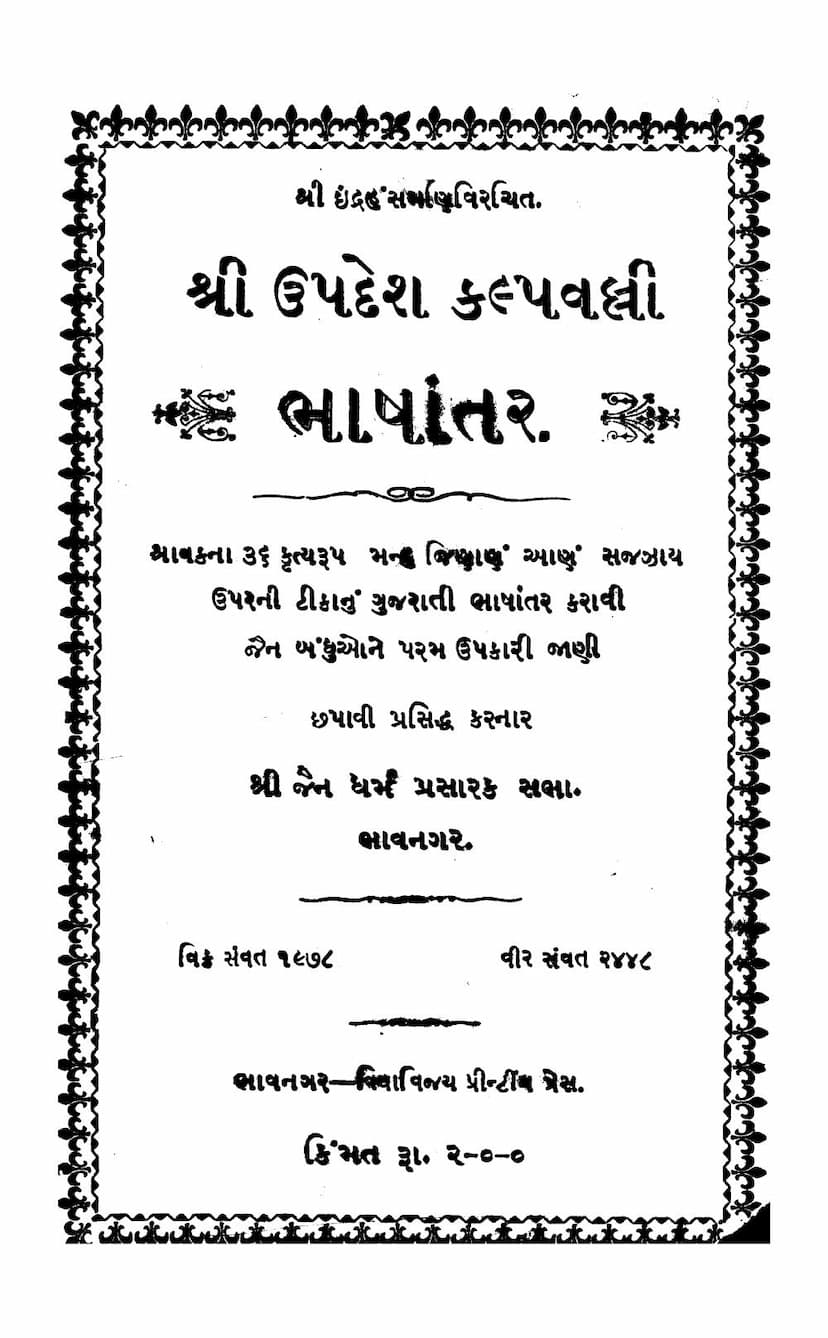Updesh Kalpvalli Bhashantar
Added to library: September 2, 2025

Summary
Updesh Kalpvalli Bhashantar: A Summary
Title: Updesh Kalpvalli Bhashantar (Translation of Updesh Kalpvalli) Author: Indrahans Gani Publisher: Jain Dharm Prasarak Sabha, Bhavnagar Year of Publication: Vik. Samvat 1978 / Veer Samvat 2448
This book, "Updesh Kalpvalli Bhashantar," is a Gujarati translation of a commentary by Indrahans Gani on a "Sajhzhay" (a type of devotional song or hymn) titled "Mannh Jinanu Aanun" (Follow the Commands of the Jinas). The original commentary itself is a detailed explanation of the 36 "krutya" (duties or practices) of a lay follower (Shravak) in Jainism. Each of these 36 duties is illustrated with a story, and some duties have two stories.
Key Aspects and Content:
-
Structure and Content: The book meticulously details 36 essential duties for Jain lay followers, each accompanied by illustrative stories. Some duties are further enriched with two stories. Only the "Chaturvinshti Stavana" (Praise of the 24 Tirthankaras) section lacks a narrative illustration. The stories vary in length, from brief to quite extensive, with the tale of Vimal Mantri being particularly noteworthy for its detail. The author acknowledges that some of these stories possess a unique quality compared to those found in other Jain biographies and character sketches, highlighting the distinctiveness of the stories in the 26th (Kuragadu Muni) and 28th (Vrihadradh) chapters.
-
Author's Lineage and Beliefs: Indrahans Gani identifies himself as belonging to the Tapagachha lineage. The text traces his spiritual lineage through several prominent Suris, including Samasundar Suri, Munisundar Suri, Jayachandra Raj, Ratnashekhar Suri, Udayanandi, Sursundar, Lakshmisagar, Samdev, Ratnamandana, Samajas, Indranandi, Dharmhans Gani, and finally himself, Indrahans Gani. The preface author suggests that Indrahans Gani might have diverged from the strict interpretations of the lineage, possibly emphasizing the importance of "Nigam" (which seems to refer to Vedic or scriptural traditions outside of core Jain Agamas) over the Agamas themselves. This inclination, initially subtle, becomes more pronounced in the later parts of the commentary, where the author elaborates significantly on the nature of the Vedas, Upanishads, Shruti, Nigam, Shraddhadev, and Shraddhadevi.
-
Controversial or Non-Conforming Views: The preface author points out a specific passage on page 337 where Indrahans Gani states that ignoring "Nigam" and solely pursuing the meaning of Agamas is considered "Sanshayik Mithyatva" (erroneous belief born of doubt) according to previous scholars. This statement is presented as being absent from standard Jain doctrine. The preface also notes that the author extensively supports "Nigam" in various places. On page 332, a point related to "Agam-Nigam Shatak" is discussed. On page 334, the translator mentions omitting many details regarding "Agam and Nigam" from the original text due to their obscurity, uselessness, and unsuitability, noting that they primarily seemed to bolster "Nigam." The translation also includes a discussion of the 36 Upanishads mentioned by Bharat Chakravarti in the text (pages 224-228), but the preface author expresses doubt about the veracity of this account.
-
Emphasis on Vedic and Other Traditions: The author repeatedly emphasizes and validates the Vedas, Upanishads, Shruti, and Nigam. A notable quote attributes the Vedas to King Bharat, contrasting them with the Agamas which are considered newly created by the Ganadharas of each Tirthankara. The author also defines "Sangh" (community) into six categories: Sadhus, Sadhvis, Shraddhadev, Shraddhadevi, Shravak, and Shravika. The preface author questions the rationale for differentiating Shraddhadev (identifying them with Brahmins) as separate from Shravak/Shravika, implying a distinct belief system.
-
Criticism of Guru Stuti and Agam Claims: The preface author critiques the 21st chapter, "Guru Stuti," for allegedly containing exaggerations in the biography of his guru, Dharmhans Gani. Furthermore, the preface questions the author's claim of 4410 Ganadharas in the 35th chapter, contrasting it with the generally accepted number of 1452 Ganadharas across the 24 Tirthankaras.
-
Omissions in Translation: Due to the problematic nature of certain passages, particularly those reinforcing "Nigam" over Agam, parts of the translation were omitted. The preface expresses regret for needing to point out the author's perceived "mistakes" rather than solely praising him. The decision was made to complete the publication of the book despite these discrepancies, as a significant portion was already printed.
-
Content of the 36 Duties: The book systematically covers various aspects of a lay follower's life and practices. The duties include:
- Adhering to Jineshvar's commands.
- Abandoning false beliefs.
- Maintaining right faith.
- Observing Samayika (meditation/equanimity).
- Performing Chaturvinshti Stavana (praise of 24 Tirthankaras).
- Vandan (obeisance) and other rituals.
- Pratikraman (confession/repentance).
- Kayotsarga (standing meditation).
- Prayashchitta (atonement).
- Fasting on specific dates.
- Practicing charity (Dana).
- Observing chastity (Shiyal).
- Performing penance (Tapa).
- Cultivating good thoughts (Shubh Bhav).
- Remembering the Navkar mantra.
- Performing acts of service (Paropkar).
- Practicing self-control (Jayan).
- Worshipping Jineshvar.
- Praising Jineshvar.
- Honoring the Guru.
- Practicing Sadharmivatsalya (compassion towards fellow practitioners).
- Ensuring purity in dealings (Vyavahar Shuddhi).
- Participating in Rathyatra (chariot procession).
- Undertaking pilgrimages (Tirth Yatra).
- Cultivating inner peace (Upasham).
- Practicing discrimination (Vivek).
- Observing restraint (Sanvar).
- Speaking truthfully (Bhasha Samiti).
- Showing compassion to all beings (Karuna).
- Associating with the virtuous (Dharmik Jan Sang).
- Subduing the senses (Indriya Daman).
- Progressing in righteous conduct (Charitra Parinam).
- Honoring the Sangh (community).
- Promoting religious texts (Granth Lekhan).
- Glorifying the Tirth (holy places).
-
Overall Purpose: The book aims to guide lay Jains in their daily spiritual and ethical practices, providing both scriptural guidance and illustrative stories to foster devotion and adherence to Jain principles. However, the preface also highlights the author's unique interpretations and emphasis on certain traditions, particularly "Nigam," which deviates from some mainstream Jain perspectives.